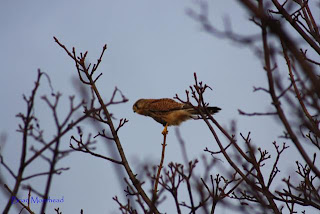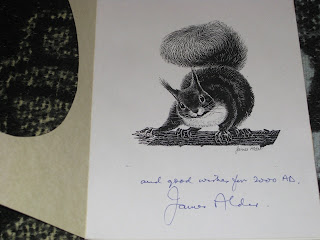31 Dec. I’m more
than satisfied that 2012 has given me what I wished for, good health, happiness
and good nature watching with good mates (also a Pomarine Skua, if somewhat
distant!). In my customary fashion I
consider some of the highlights below. (All photos taken on patch within ten minutes from my house. Not bad for a Towny!).
Wettest Moments. Despite a year of heavy rains, mud and floods
I don’t recall too many soakings. I
guess one of the biggest drenchings was in September when watching the fall of
migrant birds with fellow all weather
birder Tom. Water poured from Tom’s
boots and we were so wet we cancelled plans for the fish and chips! It was never the less a grand day and we
dried out the following day as we watched even more migrants. Oh, and I mustn’t forget the downpour on the
cliffs at St Abbs when Sam, Malcolm and I were acting as sponges. It did put a bit of a dampener on photography
plans, but not all. We dried out in the sun later. The walk had started well with a pair of Peregrine Falcons flying close to the
cliffs and a Black Redstart greeting
us in the car park. The trip en-route
was wet too, as someone (who shall remain nameless) attempted to flood the
coach with tea when a flask accidently broke.:-) Members were treated to ‘morning teas’
although I noticed it didn’t prevent some disappearing into the teas shops on
arrival at St Abbs to begin their café
list! (Sadly, I know some locals
were hit heavily by the floods and I hope 2013 sees them dry)
Coldest Moments. Without doubt this was in Norfolk in January as Andrew, Oliver, Tom and
I watched geese, including the Lesser
White Fronted Goose. I felt cold and
nauseous at the time, but later picked up as we watched fifty plus Marsh Harriers (thirty plus in the air
at one time) fly in to roost along with Common
Cranes, Hen Harrier, Merlin and Kestrel. The fish and chips at Great Yarmouth in the
evening did not approach the quality to which I have become accustomed, despite
being twice the price, but I enjoyed the pint afterwards! My tip is simply don’t go to Norfolk if it’s a fish and chip supper you're
after!
Hottest Moments. This has to be the idyllic hot weekend that
Sam and I spent the Saturday at Wylam on the banks of the Tyne
when birding included photographing a village cricket match. The following day was even hotter when I
joined Sam and Malcolm on a walk at Hadrian’s Wall at Crag Lough and also up to
Hareshaw Linn, Bellingham.
The latter day was very hot, humid and tiring (and I misjudged the
distance to the waterfall, so may not have been too popular.:-)), but we left
dreaming of summer days to come. They didn’t! The walk at Hareshaw Linn could so easily
have been highlighted in my wettest
moments as I slipped on algae covered rocks and almost fell into the river
with all my gear! Two great days and
perhaps the carpets of Water Avens provided my Botanical Moments of the year
Most Distant Trip. As last year it was the couple of days spent
birding in Norfolk
which brought over one hundred species including the elusive Golden Pheasant. It’s the geese, Marsh Harriers and Common
Cranes I remember best.
Most Surreal
Experience. I think that has to
be Sam managing to add a monkey species to an RSPB trip list on our return from
Leighton Moss. I kid you not. We did have a monkey. Probably give me my best Laugh of the Year (along with another, that I won’t put on my family friendly blog), as we sat and
watched serious faces on the coach as they noted that someone had added monkey
to the trip list. No one asked who had
seen it! Life can be taken too seriously you know! At least one or two had a chuckle.
Briefest Bird
Sighting. That has to be the Bearded Tit (I refuse to call it a Reedling :-)) seen at Leighton
Moss. We relied upon a blurred image
taken by Sam to confirm the species.
Never mind, they all count!
Birds of the Year. I tried to whittle this down to a top five,
but gave up trying and make no apologies for lack of rarities, as that will
never be my criteria for the amount of enjoyment a bird or birding gives. The enjoyment for me comes form the all round
experience. So here are a few in no
particular order, Great Crested Grebes watched and studied at length on
patch throughout most of the year by Sam and me, Bitterns seen at Gosforth Park with Cain and then Sam, the latter
becoming Bittern Magnet of
the Year, Jack Snipe which finally became a lifer and gave great sightings at Cresswell, Great Grey Shrike obligingly perching
on a fence next to me at Prestwick Carr and perhaps giving me my best ever
sighting of a species I have seen many times, Dippers (a favourite species) which Sam and I have studied for many
hours this year at a number of
territories, Short-eared Owls again watched over many hours by Sam and I, European Roller watched in Yorkshire
along with Sam and Tom and perhaps the nearest I came to twitching this year
and Grey Phalaropes seen on the
North Sea Pelagic with NEW Tours when accompanied by Cain and Tom et al. I ought not to forget the Peregrine Falcon that almost flew into
the faces of Tom and I at the Tower Hide, Seaton Sluice. Where’s ya
camera when you need it? Mine was
back at home! I have seen more Peregrine Falcons in 2012 than ever
before. Best also add the Water Rail seen in Jesmond Dene in
January, a first on the record books for the dene area in over one hundred
years.
Find of the Year. Walk at Howick introduced to me by my friend
Hilary, which gave me ‘Last night I
dreamt I went to Howick again’ moments.
Best done when it’s quiet of folk, even if that means in the rain! Wonderful to walk from the woods towards the
bay and sea. They do a very nice coffee
and walnut cake up there too and I’m able to sneak into the café unnoticed and
so avoid any association with ‘teashop
birders’.
Irritants of the
Year. Surprisingly few and minor
ones are not worth a mention in any event! Must highlight the mosquitoes in
Gosforth Park Nature Reserve, which in the summer set my allergy off and left
me with hands twice the size as normal!
So bad was the reaction I decided to cancel a planned trip to Slaley for
Nightjars as I feared another dose.
Those damn Piriton tablets have a depressing effect too, although at
least the itching calms down and you just feel crap instead. I’ll also include empty vessels as in ‘empty vessels make most sound’ types,
and those who always think they know best, but rarely move their butts to do
anything for wildlife or anything else of importance.
Most Exciting
Mammalian Experience. No doubt
about this one being the pod of White-beaked
Dolphins watched by Sam and me passing Holy Island
in October. The best UK cetacean
experience I’ve had and the fact that we were watching three Short-eared Owls too at the time only
helped add to it. That day on the island
was one of the best days of the year.
Also good to see that the Red
Squirrel hangs on in Gosforth Park Nature Reserve too. This was seen in December after we had found
three Bitterns.
Most Rewarding
Experiences. Dipper watching by several river banks,
Short-eared Owl watching on several evenings under forever changing skies at my
favourite local area of Holywell, watching Great
Crested Grebes raise two broods on patch, the fifty Marsh Harriers with Common
Cranes et al seen at one site in Norfolk, the Sept migrant fall at
Tynemouth and St Mary’s Island, becoming involved in photography (especially
the Macro element) and my involvement in various other ongoing projects with
Sam.
Unusual Experience. Seeing a Common
Buzzard lifting with an Adder as
prey on a return from Harthope
Valley with Sam, Cain and
Phil. An excellent day.
Membership Giving
the Best Value. With free entry
to umpteen talks and fieldtrips available along with entry to Gosforth Park
Nature Reserve and lots of literature and internet updates it has to be
membership of the revamped Natural History Society of Northumbria.
Best Investment. My Canon 100mm 2.8 Macro IS. I reckon 2013 will see it in use quite a bit!
Well, 2012, the year of the Short-eared Owl is ending. I’d like to say all the best to everyone for
2013, but especially to those who I have been able to trust and rely on
throughout the year, and those who inspire me, help me and/or make me
smile. I’m especially keen to see
youngsters take an interest in nature and I’ve been very fortunate throughout
2012 to often have had a very knowledgeable guy who shares my passion for
nature along side me. Thanks for
reminding me of what’s important Sam and I look forward to our joint 2013
projects and exploits. We have a good
few on the calendar (supplied by Under the Hood Photography) already. My only real resolutions are to continue to
take a keen interest in bird and wildlife ecology, behaviour and conservation,
remembering that identification is only part
of the whole, and of course take forward my photography not only in the
area of nature, but also landscape (there’s a hint there to someone!:-)) Oh, and of course, keep all my promises and
one promise I have made myself is to remain Killy ‘Non-competitive’ Birder.:-)
Sam Hood, great young naturalist, great friend and Bittern Magnet.
Now if you’ve bothered to read up to here it’s time you sat
back, put you feet up and relax and remember that austerity may be over by 2018
if ‘that man’ has his figures
correct, which I very much doubt! Maybe Killingworth
Lake will have a new
floating reed-bed by 2018 too!
HAPPY NEW YEAR
If life seems jolly
rotten, there's something you've forgotten
And that's to laugh and smile and dance and sing
When you're feeling in the dumps, don't be silly, chumps
Just purse your lips and whistle, that's the thing
And that's to laugh and smile and dance and sing
When you're feeling in the dumps, don't be silly, chumps
Just purse your lips and whistle, that's the thing
Always look on the
bright side of life
Always look on the
right side of life
With thanks to Monty Python









































